Related Research Articles

The Great Train Robbery was the robbery of £2.61 million from a Royal Mail train travelling from Glasgow to London on the West Coast Main Line in the early hours of 8 August 1963 at Bridego Railway Bridge, Ledburn, near Mentmore in Buckinghamshire, England.

Peterborough County is a county and census division located in Southern Ontario, Canada. The county seat is the City of Peterborough, which is independent of the county.

The City of Kawartha Lakes is a single-tier municipality in Central Ontario, Canada. Though structured as a single-tier municipality, Kawartha Lakes is the size of a typical Ontario county and is mostly rural. It is the second largest single-tier municipality in Ontario by land area.
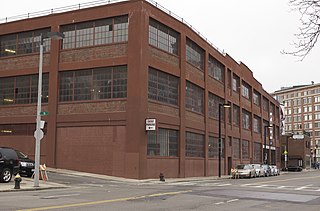
The Great Brink's Robbery was an armed robbery of the Brink's building in the North End of Boston, Massachusetts, on January 17, 1950. The $2.775 million theft consisted of $1,218,211.29 in cash and $1,557,183.83 in checks, money orders, and other securities. It was at the time the largest robbery in the history of the United States and has been called "the crime of the century". The robbery remained unsolved for nearly six years, until estranged group member Joseph O'Keefe testified only days before the statute of limitations would have expired.
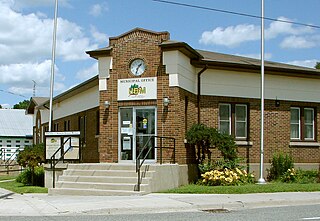
Havelock-Belmont-Methuen is a township in central-eastern Ontario, Canada, in Peterborough County. On January 1, 1998, Belmont and Methuen Township amalgamated with the Village of Havelock to form what is now Havelock-Belmont-Methuen.
The Boyd Gang was a notorious criminal gang based in Toronto, Ontario, Canada, named for member Edwin Alonzo Boyd. The gang was famous in the media at the time because of their actions, which included bank robberies, jail breaks, relationships with women, gun fights, manhunts, and captures.
The West End Gang is a Canadian organized crime group in Montreal, Quebec. An Irish mob group originating from the Irish-Canadian ethnic enclave of Pointe-Saint-Charles in the 1950s, the majority of the gang's earnings were initially derived from truck hijackings, home invasions, kidnapping, protection rackets, extortion, and armed robbery, with its criminal activities focused on, but not restricted to, the west side of Montreal. The West End Gang came to prominence via a series of high-profile bank robberies between the 1950s and the 1970s, a period when Montreal was known as "Bank Robbery capital of North America". Due to the gang's control of illegal activity at the Port of Montreal, it moved into drug trafficking and became one of the most influential criminal organizations in Canada.
Brian Arthur Field was an English solicitor's clerk who was one of the masterminds of the 1963 Great Train Robbery. He was the crucial link between the key informant known only as "Ulsterman" with the actual gang capable of planning and carrying out such a complex and large scale robbery. He was found guilty of conspiracy to rob, but his conviction was later overturned on appeal. Field only served prison sentence for perverting the course of justice, in relation to arranging the purchase of Leatherslade Farm, near Oakley, Buckinghamshire, which was used as the gang's hideout.
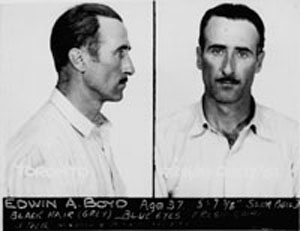
Edwin Alonzo Boyd was a Canadian bank robber and leader of the Boyd Gang. His career made him a notorious Canadian folk hero.

The 2006 Securitas depot robbery in Tonbridge, England, was the UK's largest cash heist. It began with a kidnapping on the evening of 21 February 2006 and ended in the early hours of 22 February, when seven criminals stole almost £53 million. The gang left behind another £154 million because they did not have the means to transport it.

On 5 April 2004, at 8 AM the Nokas Cash Handling in Stavanger, Norway was raided by heavily armed men. It was the biggest-ever heist in Norway.
George Earl "The Kid" Northern (1903–1936) was a Prohibition-era bank robber and early associate of Harry Pierpont. He was the older brother of Pierpont's girlfriend, Mary Kinder.
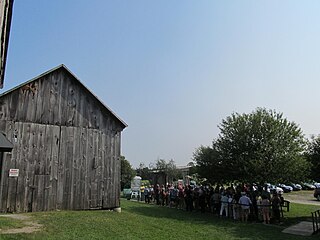
The 4th Line Theatre is a Canadian theatre company located near the small town of Millbrook, Ontario in the township of Cavan Monaghan.
Jeffrey Shuman is an American-French bank robber, dubbed "The Vaulter", considered to be one of Canada's most prolific bank robbers. In 1994, he pleaded guilty to robbing 14 banks in the United States, receiving a 12-year sentence, but was released in 2004, and fled the country while on parole. He then robbed 21 banks in Canada, before fleeing to France on his French passport. In 2016, he was extradited to Canada, and in 2017, was sentenced to 15 years in prison and ordered to pay back nearly $450,000 in restitution after pleading guilty to seven counts of robbery using a firearm.
The city of London, Ontario, Canada was established in 1826, and has since grown into Canada's 11th largest municipality. The city has had a long history of organized crime, with several high-profile incidents occurring there over the years. In 1901, London's first MP, John Carling, attributed the growth of London to three factors: the establishment of regional courts and administration in 1826, the arrival of the military garrison in 1838, and the arrival of the railway in 1853. From its position along the Quebec City–Windsor Corridor, the city has attracted investment in commerce, culture and manufacturing, and attracted criminal enterprises to exploit that growth.

On June 28, 2022, a shootout occurred between two gunmen and responding police officers following a robbery of a Bank of Montreal branch in Saanich, British Columbia, Canada. Both gunmen, later identified as twin brothers Mathew and Isaac Auchterlonie, were killed by police, while six officers were injured, three of them severely.
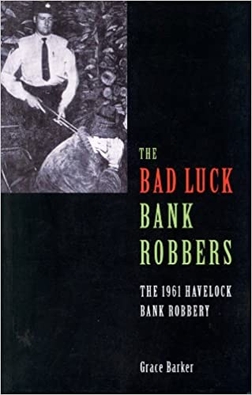
Bad Luck Bank Robbers is a 2006 book by Canadian historian Grace Barker about the Havelock Bank Robbery.
Gilbert William Galvan Jr. is an American bank robber. Having spent many of his adult years in prison, Galvan fled to Canada where he assumed the name Robert Lee Whiteman and began a three-year spree robbing banks and jewelry stores in the 1980s. The media dubbed him the Flying Bandit and the Phantom Bandit. Galvan's exploits were the subject of a 1996 true crime book, The Flying Bandit, written by Robert Knuckle and Ed Arnold, which was adapted into the 2022 film Bandit.
The Virginiatown Bank Robbery was a 1972 robbery of the Canadian Imperial Bank of Commerce in Virginiatown, Ontario, Canada.
References
- 1 2 3 4 5 6 7 8 9 10 11 Hodgins, Bill (19 August 2021). "BEHIND THE CRIMES: Bank bandits hid in basement in one of Canada's biggest robberies at the time". The Toronto Star. ISSN 0319-0781 . Retrieved 29 June 2022.
- 1 2 3 4 5 Gillies, John (4 September 1961). "Police Hunt $185,000 hidden loot, capture bank robbery suspects". Globe and Mail.
- 1 2 3 4 5 6 Powell, Kelsey (16 December 2014). "Is $230,000 in stolen loot hidden near Bancroft?". kawarthaNOW. Retrieved 29 June 2022.
- 1 2 Eadie, Jim (5 April 2016). "Township gets $1.4 million". Bancroft this Week. Retrieved 29 June 2022.
- 1 2 Campbell, John (15 September 2015). "Bank robbery mystery still captures the imagination". DurhamRegion.com. Retrieved 29 June 2022.
- 1 2 3 "Bank's cash bag discovered in wall during renovations adds to Havelock robbery tale". thepeterboroughexaminer.com. 4 September 2021. Retrieved 29 June 2022.
- ↑ Graham, Karen (9 July 2015). "Retired Officer Remembers Robbery Featured in 4th Line Theatre Play". The Millbrook Times. Retrieved 29 June 2022.
- ↑ "Here's Mark Bonokoski's take on the mystery $230,000 bank robbers may have stashed near Coe Hill | coehillworld.com". 27 June 2015. Archived from the original on 27 June 2015. Retrieved 29 June 2022.
- ↑ Barker, Grace (2006). The Bad Luck Bank Robbers: The 1961 Havelock Bank Robbery. Dawn Publishing. ISBN 9780969629825.
- ↑ Powell, Kelsey (20 December 2014). "The trail is cold, but the loot is still out there..." Retrieved 29 June 2022– via PressReader.
- ↑ Tweedle, Sam (13 August 2016). "Crime shouldn't be this funny – a review of The Bad Luck Bank Robbers". kawarthaNOW. Retrieved 29 June 2022.